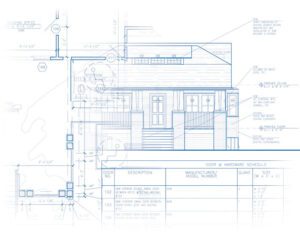In 2015, Adamick Architecture completed part I and part II tax credit applications for four projects, each of which received a minimum of $100,000 in tax credits. Adamick Architecture has developed good relationships with the state historic preservation office and is happy to assist our clients with this process in tandem with their design. Tax credits were introduced as a way to encourage the rehabilitation of existing buildings in Louisiana’s cultural corridors. This interest in preserving the historic character of structures and spurring economic development results in lucrative returns for residential and commercial renovation projects. This article seeks to explain how tax credits can be utilized in historic renovations.
A tax credit is a credit towards your tax liability that is also transferable. The credits are awarded to the taxpayer at the completion of a project. The tax credit is given to the person or entity that holds the property title. For example, if you owe $8,000 in taxes and you have a $5,000 credit, then you would only owe $3,000 in taxes. There are state and federal tax credits that can be paired together. For instance, a commercial historic renovation could be eligible for 45% of qualified expenses in state and federal tax credits where 25% comes from the state and 20% comes from the federal government.
State Commercial Tax Credits
This 20% credit is for qualified rehabilitative expenditures (QREs). QREs are the cost of rehabilitating the building, including but not limited to materials, labor, plumbing fixtures, mechanical equipment, sprinkler systems, windows, doors, stairs, chimneys, electrical work, alarm systems, and fees (including architectural services). For example, if you spent $50,000 rehabilitating a historic building for commercial use then you can expect a $20,000 tax credit (including federal tax credit). Not every expense, however, is a QRE. Some exclusions include the price of obtaining the property, new construction, cabinetry, decks, and landscaping including fences and parking lots. This program is scheduled to end on December 31, 2021.
Federal Rehabilitation Tax Credits
The federal rehabilitation tax credit program is administered and overseen by the National Park Service (NPS) and the Internal Revenue Service (IRS). Two different tax credits are available for eligible structures, for 20% and 10% respectively.
- 20% Tax Credit. This credit is available for historic buildings that produce an income and are listed individually on the National Register of Historic Places or are located in a National Register Historic District. Much of New Orleans lies within a national historic district. This credit is 20% of your QREs and is disbursed once the building is put into operation. In order for the rehabilitation to qualify, it must exceed the value of the historic building and the same tax payer must keep ownership for five years in order to take full advantage of the 20% credit.
- 10% Tax Credit. Non-historic, non-residential buildings constructed before 1936 may qualify for a 10% tax credit for QREs. This 10% credit may only apply to the substantial rehabilitation of a building for a non-residential use. (Rental properties, for instance, would not qualify.) Historic buildings listed on the National Register of Historic Places or located within a National Register Historic District are not eligible for the 10% tax credit. Specific rules apply for how much of the existing structure must remain: At least 75% of all existing exterior walls must remain in place. At least 50% of the exterior walls must remain exposed on the exterior of the building. In addition, 75% of the interior structural framework must be maintained.
Both the 20% and 10% federal rehabilitation tax credits may only be used for substantial renovations. Rehabilitation, renovation, and reconstruction expenditures must exceed adjusted tax basis or $5,000 minimum for qualified expenses, and all such work must comply with the Secretary of the Interior’s Standards for Rehabilitation and Guidelines for Rehabilitating Historic Buildings. The tax credits are also only applicable to work within the original building footprint and envelop for the rehabilitation of a historic building. In other words, additions or new construction outside the original building footprint would not be eligible for federal rehabilitation tax credits.
Other Tax-Related Incentives
In addition to state and federal tax credits for historic buildings, there are other tax-related incentives available that can provide additional value to historic rehabilitation projects. These include but are not limited to the following:
- Restoration Tax Abatement. The Restoration Tax Abatement program through the state of Louisiana can confer an abatement for up to ten years on property taxes on improvements and renovations of existing commercial and owner-occupied residences. Such abatements encourage growth in economic and downtown development districts, not just historic districts.
- Low Income Housing Tax Credit. This federal program provides tax incentives to encourage developers to create affordable housing. In return, developers rent the housing at an affordable amount, which is usually below market rate (also called a use restriction).
- New Market Tax Credits. The New Market Tax Credit Program (NMTC Program) through the Federal government helps economically distressed communities attract private investment capital by providing investors with a Federal tax credit. Investments made through the NMTC Program are used to finance businesses and real estate projects, breathing new life into neglected, underserved low income communities.
- Louisiana Cultural Districts. Local governments may designated cultural districts approved by the state of Louisiana, Division of Arts, for the “purpose of revitalizing a community by creating a hub of cultural activity.” Buildings within cultural districts may receive income and corporate franchise tax credits for qualified expenses for the rehabilitation of owner-occupied or revenue-generating historic structures within a cultural district.
Historic Tax Credit Process
The process varies depending on the specific type of credit, but generally follows the following process: Once a property has been identified as likely to be eligible for the chosen tax credit, the property owner participates in an application process for the credit. The application then is reviewed by the appropriate entities, and eligibility and amount of credits are determined based on the Qualified Rehabilitation Expenditures. Credits are disbursed to the property owner, who then has the option to apply them to his or her taxes at the end of the year.
The individual or entity owning a historic property and receiving state or federal tax credits may choose to transfer the tax credits, using one of several legal arrangement to transfer part or all of the tax credit as part of a financial transaction. A robust marketplace exists for transferring historic tax credits. Depending on the size and nature of the historic tax credits involved, obtaining 80% of the value of the tax credits are common in transactions. Such transfers allow individuals or entities that may not be able to fully benefit from the tax credits, such as non-profit organizations or individuals with limited passive income, for instance. State historic tax credits have significantly less restrictive rules for transactions than do federal tax credits.

Case Study: Side Gallery House in the Lower Garden District
Adamick Architecture has assisted a number of building owners in obtaining both historic tax credits, including the rehabilitation of a side gallery house on Melpomene Street in the Lower Garden District. The application established the house as a contributing structure in the historic Lower Garden District Neighborhood. The building sits on a lot that was part of the Saulet plantation before the subdivision in the 1800’s, across the street from the site of the old Saulet home which was demolished in 1959. For this historic rehabilitation project, Adamick Architecture provided support in the historical documentation and application process for both State Rehabilitation Tax Credits and the 20% Federal Rehabilitation Tax Credits.
The application process was two-fold: For the first part, Adamick Architecture documented the existing building and described its historic character to establish eligibility as a certified historic structure with the state historic preservation office. Built before 1895, this two-story wood house has architectural merit as a fine example of the side gallery house type in New Orleans. For the second part of the application, we documented the scope of work for rehabilitation, to identify Qualified Rehabilitation Expenditures, including repairs such as replacing missing siding and plasterwork, and new work including upgrading the interior spaces to be a private residence. This documentation also established that the work would conform with the Secretary of Interior’s Standards for Rehabilitation. With the help of Adamick Architecture, the owner successfully qualifying for $112,500 in historic tax credits, which significantly reduced the overall cost of the rehabilitation project.
Disclaimer: The information above is intended for educational purposes only, and does not represent professional legal or tax-related advice.



